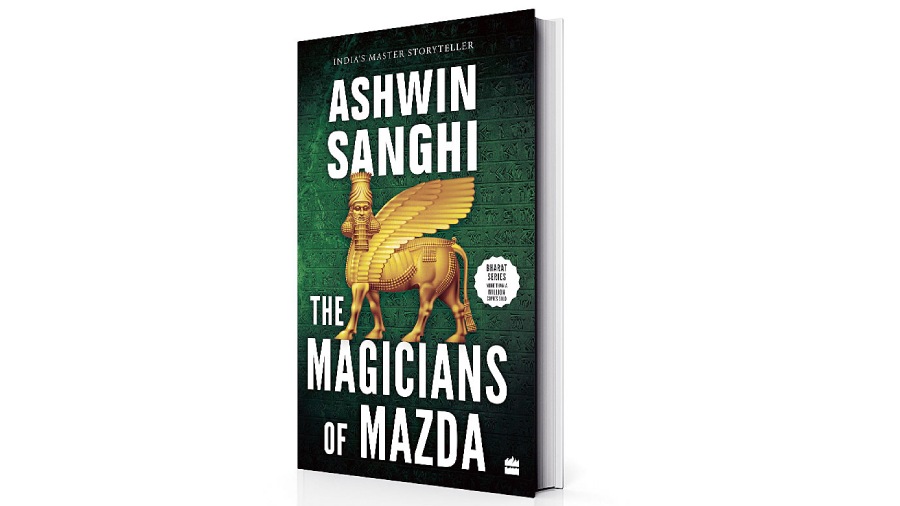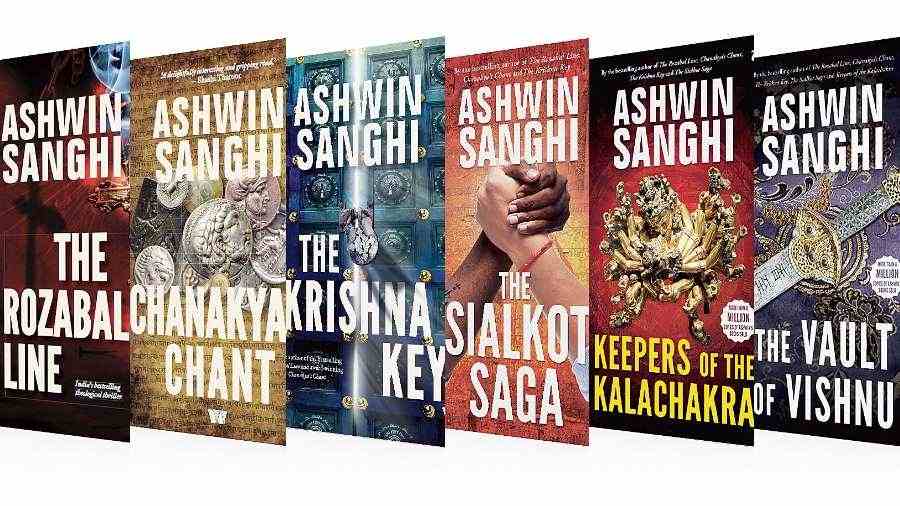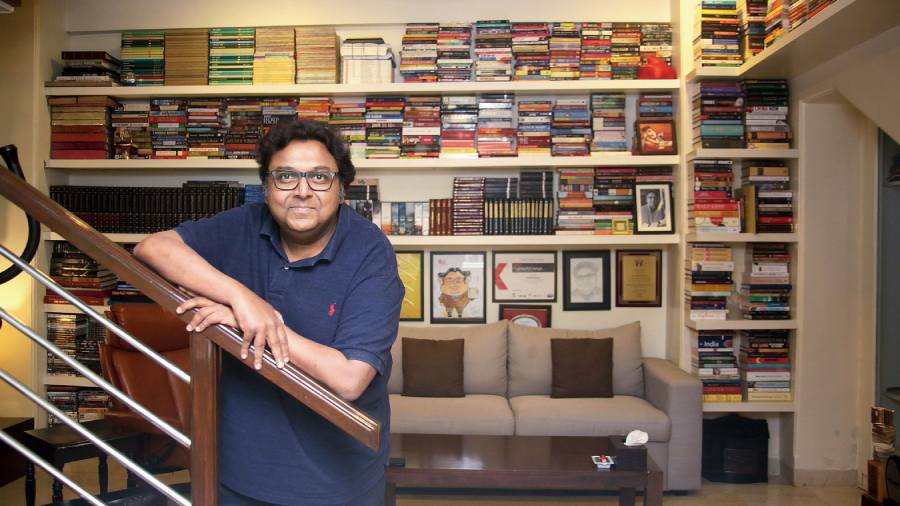We last spoke to Ashwin Sanghi in 2020, when his book The Vault of Vishnu had released. He had spoken about his next one and anticipated a launch in 2022. A stickler for deadlines, as promised, The Magicians of Mazda has now been published by HarperCollins India. A Westland author through and through, he had faced 47 rejections for his first manuscript of The Rozabal Line before Gautam Padmanabhan of Westland Books went ahead with the print. The rest, as they say, is history. Seven fiction books later with a sprinkling of several non-fiction books in between, he has been on the Forbes’ influential lists and has sold millions of copies. Westland may have unceremoniously shut doors in India because of a corporate decision from Amazon, but his books have found a new home. Operating on his famous “70-20-10 rule of E”, which translates to 70 per cent entertainment, 20 per cent education or sharing of information that the reader perhaps didn’t have before and 10 per cent enlightenment or that moment that makes the readers wonder how they didn’t think of this connection before, Sanghi’s writing is as clear as it is pacy.
The Magicians of Mazda has him delving into the Zoroastrian faith, taking his Parsi protagonist Jim Dastoor across the world, abducted from his science lab in Seattle and taken to Tehran. The Ayatollah firmly believe that Dastoor is the key to their relic Athravan Star and will go to any lengths to acquire it. Dastoor’s cat-and-mouse chase takes him from the ruins of Persepolis to Taliban camps in Afghanistan, from the Udavada fire temple to Kashmir to Tehran to Diu. And keeping this Parsi scientist company is Sanghi’s fascinating style of storytelling that ensures that readers find a comfort spot on the very edge of their seats. “When we spoke in 2020, I already had a kernel of the idea that I wanted to explore the overlaps between Zoroastrian and Vedic elements,” he said in a conversation with The Telegraph over Zoom. Excerpts.
Tell us about the inception of The Magicians of Mazda and your wish to explore the Zoroastrian faith.
Each of the books in the Bharat Series is an exploration of overlaps. The Rozabal Line had him delving into Christian theory and Buddhism; Keepers of the Kalachakra was an overlap between Vedanta and quantum theory; The Krishna Key spoke of the events as described in The Mahabharata versus the Saraswati civilisation. Over the years, these connections have been the focus of the Bharat Series. So the idea for this book was also born from these similarities. The Avesta (Zoroastrian religious text) reveres the cow and the sacred fire; Varuna and Mithra (deities worshipped in the Avesta) are respected not just in the Gathas (Younger Avesta) but also in the Rig Veda (Hindu Vedic text); Zoroastrians’ yasnas are very similar to the yagnas of the Vedic period. I find these facts fascinating! We may like to think that the Parsis came to India through Sanjan (in Gujarat) in around 1700 CE, frankly the contact between the Parsis and Indians go back much further. Gujarat lay along the maritime routes that were used by Zoroastrian sailors. Even The Mahabharata uses a term —Parsicas –– those people who lived to the west of the Indus. In other words, these weren’t people who were unfamiliar to the Indian landscape. So I wanted to explore these ancient connections through the format of a very fast-paced, entertaining, suspense thriller and that’s how this book was conceived.

So the idea for this book was also born from these similarities. The Avesta (Zoroastrian religious text) reveres the cow and the sacred fire; Varuna and Mithra (deities worshipped in the Avesta) are respected not just in the Gathas (Younger Avesta) but also in the Rig Veda (Hindu Vedic text); Zoroastrians’ yasnas are very similar to the yagnas of the Vedic period. I find these facts fascinating!
In your exploration of various theisms in a political climate that is increasingly volatile with people taking offence in the smallest of things, is there ever a moment of fear of backlash?
One part of it is always the challenge of writing about a community that you are not a part of. As a Hindu, it’s easier for me to write about Hindu mythology than for me to explore the Zoroastrian faith. There are a few rules when you write about such topics. I believe that it is very important to say upfront that what you are writing is a work of fiction for the purpose of entertainment, which is not to be considered in any way factual. In my disclaimers for each of the books in the Bharat Series, I have said that even if one feels it is a fact, consider it fiction. So look beyond my mythological, historical and theological elements and treat everything as fiction. I love facts that sound like fiction and fiction that sounds like facts! At the end of the day, all I am trying to do is spin a yarn and make it believable.
I also think that you owe it to your reader to do the best possible research you can. Fiction writers are spinners of yarns and I happen to also be known as a conspiracy writer; that I adore alternative scenarios, the so-called ‘what if’ question. But if an alternate reality is what you are building, you are better off being as close to the reality as possible. What makes that work is when one does their research.
Finally, whenever it comes to the matter of faith, one needs to treat those figures with as much respect and reverence that one can. It becomes very evident in your writing whether you want to stir up a controversy or tell a good story –– that shines through when you treat your characters with respect. Let your readers understand that it is the starting point of a journey, which is why I always cite my sources for every piece of information shared in the book. Not just for the views I have taken in my book, but also contrasting views that may be in existence are provided references to at the back of my Bharat Series books.
Tell us about your writing process?
This is the seventh book in the Bharat Series, with the first one having come out in 2008. I have been doling out a new book every two years on average. The first two months of creating a book in the Bharat Series goes away in ideation. I maintain a very detailed journal of ideas that is in the form of an email account where I email myself! It has ideas, thoughts, web links, photographs of pages, YouTube videos. In the last so may years, I have sent myself some 12,000 emails! When I decide to write a book, I go back to this email account to look through the things that had interested me. It will take me a couple of months to choose three-four ideas and eventually narrow down on one that I can live with for the next two years of my life.
The next course of action is curating what I call the research list –– the books that I would typically need to read, papers that I would need to access, places I need to visit, people that I need to talk to. This research phase can be anywhere between six and nine months. I like to interact with people and hear their experiences from them that can be woven into the story. I travel looking forward to these interactions. In The Sialkot Saga, it involved the lives of people in post-Independence Bombay and Calcutta. I needed to know how kids were romancing in those days and how much they were paying for phuchka. These are not things I would find in a history book. Chanakya’s Chant was a lot about reading the Arthashastra and Mudra Rakshas.I will never start writing a novel till I have a complete plot outlined on an excel sheet in front of me. Each row of the sheet will contain details of each chapter. From then on, it’s the easiest bit perhaps, fleshing out each chapter and doing the actual writing. Typically, my plot outlines run to 8000-10,000-odd words and it would take me perhaps six months to complete the first manuscript.

In my disclaimers for each of the books in the Bharat Series, I have said that even if one feels it is a fact, consider it fiction. So look beyond my mythological, historical and theological elements and treat everything as fiction. I love facts that sound like fiction and fiction that sounds like facts! At the end of the day, all I am trying to do is spin a yarn and make it believable
And who is the first person to read your manuscript?
So far it has been a group of people. One of the early-stage readers is my editor who is based out of Calcutta. Not only does she get the first copy of the manuscript but also some copies in between asking, ‘How is this sounding?’
Another person who gets bits and pieces of the manuscript is my wife. I often find myself asking her, “Read this and tell me if there is enough of an incentive to want to turn the page!” The third person who I tend to chat with about these things is my publishers. I can find lots of people to fine-tune my grammar and enhance my writing but a publisher will always be concerned about the bigger picture of the story. Individual portions and sentences can be easily worked on but it is the story that matters! I have always maintained that the first page of your book has to be a pothole that your reader falls in and has no hope of getting out of.
Book promotions have evolved so much over time with book trailers in the mix. Which part of the publishing process do you enjoy the most?
Honestly, I absolutely do not like marketing. If I could stay holed up in my room just writing to my heart’s content, I would be the happiest; where I don’t have to get my hands dirty on any of the promotional aspects. However, that can not be the case. If you have spent two months writing a novel, you owe it to yourself to spend three-six months promoting the book and that’s pretty much what I do. So I tend to involve myself in the little nitty-gritty and be hands-on with these things once I have decided. For example, I will be intimately involved in the development of a trailer because that’s the first glimpse of your book that the readers are getting. And like it is said, a picture says a 1,000 words! I tend to be involved in even the store displays that happen or be active on social media during promotions. You will see me posting 15-20 times!
I used to do a lot of physical book tours city-wise but now I spend far more time on online interviews. The reality is a physical event will take you to 100-odd people but an online video can be viewed by even 40,000 people in a matter of a week. The nature of marketing has changed over time but to say that I enjoy any of it would be a complete lie! Honestly speaking, what I enjoy is the creative process. Business comes instinctively to me but it was me running away from it that took me to write. So when someone turns around and says you spent two years writing this book, now spend the rest of the time selling your own book –– that’s not something I want to be doing! But I owe it to myself to do that.
Would you like to throw some light on the Westland closure and your subsequent shift to HarperCollins Publishers?
My entire writing journey could be called the story of three Padmanabhans. And I will tell you why! When I started out, no one wanted to publish my book. Between the number of literary agents and publishing houses that turned me down, the number was about 47 over a period of 18-19 months. At that point, my manuscript had travelled to this lady called Hemu Ramaiyya who had just set up Landmark bookstores. Landmark and East West Books had come together to spawn what was known as Westland Books. She liked the manuscript and she decided to pass it on to Gautam Padmanabhan to see what he says. He read it and decided to do a focus group of readers to see what their feedback is. One of those readers was Gautam’s own father, a gentleman who was a very respected figure in the book distribution business. Senior went back to junior and said, ‘Forget what the other nine say. I think this book needs to be published because it’s an outstanding manuscript’. That’s how The Rozabal Line got published in 2008. I will always be grateful to them because had it not been for them, I would never have been published at all.
For the last 14 years, I never once thought about switching publishers. I was so happy being at home in Westland. There was no distinction between me and Westland –– I was Westland and Westland was me. Had it not been the intrinsic issues between Westland and Amazon and their subsequent restructuring, I would not have had to do this transition.
However, when it became clear that this transition was inevitable, the third Padmanabhan came into my life –– Anantha. We had been in touch for over a decade with him expressing interest in publishing me. For the longest time I kept saying no because for me, a publishing deal is as sacred as a marriage contract. But I was compelled to think of an alternate publisher –– a place I would be equally comfortable. When I was with Westland, it wasn’t them publishing me. It was Gautam publishing me. The only alternate answer in my head was Anantha, the only equivalent I could think of. Put aside commercials, where would I have that level of comfort and the answer was Anantha.

I maintain a very detailed journal of ideas that is in the form of an email account where I email myself! It has ideas, thoughts, web links, photographs of pages, YouTube videos. In the last so may years, I have sent myself some 12,000 emails! When I decide to write a book, I go back to this email account to look through the things that had interested me
Have you read any recent contemporary fiction that you liked?
I must tell you that I have ended up not reading any fiction in the last one year, primarily because I have had my hands full with this book. My reading tends to happen after the book is out there and I have completed about three months of marketing. The book came out on May 21 and I think it will be around August when I will finally go back to my Kindle and look at the things I have downloaded but not read. The one thing about me is that I may not be a voracious reader but I am a voracious downloader of books! I always have 100-odd books in the pipeline waiting to be read. There are books that I read during the phase when I am writing but those are mostly non-fiction and are related to my research. For instance, you may have not heard of this book called Zoroastrians: Their Religious Beliefs and Practices by Mary Boyce but that became a book that I had to read in-depth in order to start feeling that I knew enough. There is another book called Original Magic: The Rituals and Initiations of the Persian Magi by Stephen Flowers, which I never in my wildest dreams imagined myself picking up for leisure.
However, there are some authors whose fiction I will read come what may. If Dan Brown comes up with a new novel, I will read it in a month! But there are also authors like James Patterson who I have written books with, who come out with eight to 10 books a year! There is no way I can keep up with that. There would be a time when I would devour a John Grisham book as soon as it came out but it’s been a while since I have read Grisham. The same applies to Jeffrey Archer –– the moment he started doing five books in a series, the interest tapered off in some ways. My fiction reading, over the years, has reduced a lot!










